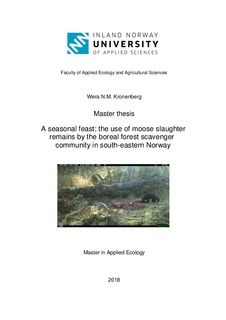| dc.description.abstract | Scavenging by vertebrates is one of multiple foraging strategies to utilize food resources and a key ecological process in food web dynamics. It is used in periods of environmental stress such as shortage of prey, and as an alternative food resource. Anthropogenic resources like hunting remains can provide scavengers with large amounts of temporally and spatially predictable nutrient rich food. However, the role and impacts of these food subsidies on the scavenger community, are still poorly understood. In this study, I investigated the use of human provided carrion from the annual moose hunt in south-eastern Norway. Remote camera traps were used to monitor scavenger utilization at 17 sites with hunting remains. I examined whether the use of these remains was affected by the amount and type of biomass, if the visit frequency of scavengers changed over time, and I quantified the total amount of biomass from the shot moose in the study area available to scavengers. All sites were visited by scavengers. The main visitors were corvid species (Corvidae), pine marten (Martes martes), and red fox (Vulpes vulpes). Every site was encountered within 24 hours after camera placement, with avian species arriving first. Sites with organs present were encountered faster, as were the sites with moose remains shot later in the hunting season. Positive correlation was found between start weight of the remains and visit frequency of mammals and large corvids. Avian species showed to be diurnal visitors, while mammals were more nocturnal. Also, the older the remains, the lower was the probability of avian scavengers to visit them. The decrease of biomass was higher for remains with organs present and was positively correlated to the scavenger biomass visiting the site. Average available biomass was estimated to 8.61 kg ± 0.03 SE per km2. I conclude that moose hunting remains are an important food source for a wide range of scavenger species in the Norwegian boreal forest. Especially in the first period of the moose hunting season this food source is very abundant, providing scavengers with an easy accessible and highly nutritious resource. This study helps to get a better understanding about the functioning of the scavenger guild. | nb_NO |
